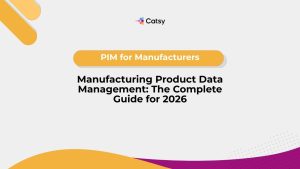Engineering Data Quality Management: Maintaining Accuracy During Frequent Spec Updates
A Guide to Data Quality Maintenance for Industrial Brands
- Ceejay S Teku
- October 5, 2025
- 4:57 am

Table of Contents
What You'll Learn:
- Why 59 percent of organizations don’t measure data quality despite poor data costing companies $12.9 million annually
- How engineering changes consume 30-50 percent of total engineering capacity when data quality isn’t properly managed
- What PIM systems prevent by eliminating 30-40 percent of wasted time spent searching for accurate specifications
- How automated data validation reduces manual cleansing by 20-30 percent while keeping specs accurate across all teams
- Why integrated PIM platforms enable faster engineering cycles and stronger competitive positioning
It’s Monday morning. Engineering just pushed another spec update. Motor efficiency changed from 92 percent to 94.2 percent. Housing material switched from aluminum to a new alloy. Connector specs changed for a different supplier.
Three small updates. One big problem.
Marketing finds the efficiency change Tuesday while preparing presentations. Manufacturing discovers the material change Wednesday when ordering components. Sales learns about connectors Thursday during a customer call—after quoting old specs.
By Friday, nobody knows what’s correct. Engineering has the latest data. Marketing uses Tuesday’s version. Manufacturing works from last week’s specs. Sales quotes a mix of old and new information.
“How do we know what we’re actually building?”
Sound familiar?
This happens weekly when engineering speed creates data chaos. When specs change constantly, keeping data accurate becomes essential for success—and devastating when done wrong.
1. Why Weekly Engineering Updates Create Data Quality Disasters
Engineering updates have accelerated as companies compete on speed and customization. Research shows engineering changes consume 30-50 percent of total capacity and represent 20-50 percent of tool costs, with frequency increasing as products get more complex.
The problem is exponential complexity. Each spec change affects multiple departments, systems, and people. A simple material change impacts procurement, manufacturing, testing, marketing, sales, documentation, and customers. Weekly changes create overlapping chaos.
Gartner research reveals 59 percent of organizations don’t measure data quality, making it impossible to understand problems or track improvements. Without measurement, teams operate blind to the data disasters they’re creating.
Multiple systems make it worse. Engineering uses CAD and PLM systems. Manufacturing relies on ERP platforms. Marketing manages content systems. Sales accesses CRM tools. Each system holds different versions of the same specs, creating endless conflicts.
Change delays compound problems. When engineering updates specs, changes must flow through multiple systems and departments. Each step adds delays, errors, and version conflicts. By the time updates reach everyone, new changes have already started.
Studies show engineers spend 30-50 percent of time on changes, but only 8.5 percent adds real value. The rest involves hunting for current info, fixing conflicts, and correcting errors from poor data management.
Teams make decisions with different data, leading to incompatible parts, wrong marketing claims, bad pricing, and manufacturing delays. These failures multiply the cost of engineering updates.
2. How Poor Data Quality Costs Manufacturers Millions
Poor data quality during frequent updates creates costs throughout organizations. Gartner shows poor data quality costs companies at least $12.9 million annually. For manufacturers with weekly updates, costs multiply as errors spread.
Engineering productivity crashes. McKinsey analysis reveals data users spend 30-40 percent of time searching for data when inventories aren’t clear, and 20-30 percent on data cleansing without proper controls. With weekly updates, these percentages increase as teams struggle to find accurate information.
Manufacturing disruption costs explode. When data quality issues reach production, they create expensive delays and rework. Components ordered with wrong specs don’t fit. Processes optimized for old specs produce defects. Quality control using incorrect parameters misses problems.
Customer relationships suffer lasting damage. Industrial customers depend on accurate specs for their own decisions. When spec errors affect delivered products, customers lose confidence and find other suppliers. Relationship costs often exceed direct error costs.
Regulatory compliance failures generate severe penalties. Industrial products need extensive documentation for safety and environmental compliance. When updates create data quality issues in regulatory docs, companies face fines, recalls, and market restrictions.
Supply chain inefficiencies ripple throughout networks. Suppliers get conflicting specs from different departments, causing confusion and delays. These problems spread through supply chains, creating costs that return as higher prices and delivery delays.
The compound effect explains why data quality management has become strategic for manufacturers competing on engineering agility.
3. What PIM Software Does to Solve Data Quality Problems
Leading manufacturers use Product Information Management (PIM) software to transform weekly engineering updates from disasters into competitive advantages. PIM systems combine automated validation, smart workflows, and real-time sync to maintain data quality across complex organizations.
Automated validation prevents errors at the source. When engineering submits changes, PIM systems automatically check specs against business rules, compatibility requirements, and consistency constraints. Invalid data can’t enter organizational systems. This prevents downstream chaos before it starts.
Real-time synchronization ensures everyone has current data. Instead of manual updates that create delays and conflicts, PIM platforms push changes immediately to all connected systems while maintaining complete audit trails of what changed, when, and who approved it.
Smart impact analysis shows the full scope of changes. PIM systems analyze relationships between components, processes, and requirements to predict how changes affect manufacturing, procurement, compliance, and customers. This helps teams make informed decisions about timing and implementation.
Version control tracks complete change history. PIM maintains full histories of spec evolution, helping teams understand how products changed over time and quickly revert if problems occur. This is essential when weekly updates create complex change sequences.
Intelligent workflows route changes appropriately. Different change types automatically go to the right stakeholders based on impact, cost, and risk. Critical changes need multiple approvals while minor updates proceed immediately with notifications.
Key PIM capabilities include:
- Automated spec validation against multiple constraints
- Real-time change sync with guaranteed consistency
- Predictive impact analysis for better decisions
- Complete audit trails and version control
- Smart workflow routing based on change type
- Automated compliance checking
- Cross-system synchronization with conflict resolution
These capabilities transform data quality from reactive problem-solving to proactive quality assurance that enables faster, more reliable engineering cycles.
4. How Smart Engineering Teams Build Competitive Advantages
Forward-thinking engineering teams use superior data quality management to accelerate innovation, reduce costs, and capture opportunities competitors miss due to data problems.
Faster innovation cycles become possible when teams can make changes confidently without fearing data chaos. Teams with robust PIM systems iterate rapidly on specs, test multiple designs, and respond quickly to market feedback. This speed enables more innovative products and faster time-to-market.
Better cross-functional collaboration emerges when all teams access current, accurate specs. Engineering changes no longer create coordination chaos because marketing, manufacturing, sales, and procurement automatically get validated updates. This enables more integrated development and reduces delays.
Improved customer responsiveness results from implementing spec changes quickly and reliably. When customers request modifications, engineering teams can evaluate feasibility, make changes, and provide accurate commitments without lengthy validation cycles. This responsiveness differentiates from competitors struggling with slow, error-prone processes.
Lower development costs accumulate as quality management eliminates waste from spec errors. Teams spend less time searching for current info, fixing conflicts, and reworking designs. This efficiency enables more development within budgets or reduces costs for equivalent outputs.
Better risk management becomes achievable when teams can accurately assess change implications. Advanced impact analysis helps understand manufacturing challenges, regulatory issues, and customer impacts before implementing changes. This prevents costly problems and enables confident decisions.
Strategic advantages compound over time:
- Faster cycles enable more product variants
- Better accuracy reduces warranty costs
- Improved collaboration accelerates innovation
- Enhanced responsiveness strengthens competitive position
- Lower costs enable additional innovation investment
- Superior risk management prevents costly failures
Companies establishing data quality as a core competency create sustainable advantages that become harder for competitors to match.
5. Why Your Data Quality Strategy Must Be Future-Ready
Manufacturing complexity will keep increasing as companies compete on customization, sustainability, and technology. Organizations building scalable data quality capabilities now will leverage accelerating change while those delaying will struggle with mounting chaos.
Digital transformation acceleration requires data foundations supporting connected products, IoT integration, and data-driven services. Engineering specs must be accurate for digital twin apps, predictive maintenance, and autonomous systems. Poor data quality blocks digital business models.
AI integration will transform data quality from manual validation to predictive assurance. AI will analyze change patterns, predict conflicts, and suggest optimal sequences based on comprehensive impact analysis. Companies with quality data will leverage these capabilities while others cannot.
Regulatory complexity growth across sustainability, safety, and cybersecurity demands automated compliance verification. Manual processes can’t keep pace with increasing requirements. Automated systems with regulatory checking become essential for market access.
Supply chain digitalization requires accurate, real-time spec sharing with suppliers and partners. Digital supply chains depend on data accuracy for automated procurement, quality verification, and performance optimization. Poor quality creates barriers to digitalization benefits.
Customer expectations evolve toward transparency, customization, and rapid response. Industrial customers increasingly expect immediate access to current specs, real-time change notifications, and accurate delivery commitments. Companies that can’t meet these expectations lose competitive positioning.
Future-ready capabilities must include:
- AI-enhanced validation and conflict prediction
- Automated regulatory compliance verification
- Real-time supply chain integration
- Predictive impact analysis for optimization
- Scalable platforms supporting increasing frequency
Engineering teams establishing advanced PIM capabilities now will be prepared for accelerating demands while creating competitive barriers that strengthen market positions.
Key Takeaways
Deploy automated validation systems that prevent spec errors from entering organizational systems, eliminating 30-40 percent of engineering time wasted searching for accurate information.
Implement real-time synchronization that ensures spec changes reach all systems and stakeholders immediately, preventing version conflicts costing millions annually.
Use predictive impact analysis that helps teams understand full change scope before implementation, reducing the 20-50 percent of tool costs from poor change management.
Create comprehensive audit trails tracking all spec changes with complete version history for quick problem resolution and compliance verification.
Build intelligent workflows that route changes to appropriate stakeholders based on impact while maintaining engineering agility.
Invest in AI-enhanced PIM platforms that automatically detect quality issues, suggest corrections, and learn from patterns to improve validation continuously.
Measure performance through validation accuracy, change propagation speed, and coordination effectiveness to optimize processes.
FAQs:
How can teams maintain agility while implementing data quality controls?
Modern PIM systems enhance rather than constrain agility. Automated validation happens in real-time without slowing updates. Intelligent workflows route changes appropriately—low-risk changes proceed immediately while critical ones get proper review.
What are the most common data quality failures during frequent updates?
Common failures include version conflicts between systems, incomplete change propagation, spec inconsistencies across departments, regulatory gaps, and supplier communication delays. These typically result from manual processes that can’t keep pace with weekly frequencies.
How do PIM systems integrate with existing engineering software?
Advanced PIM platforms provide APIs and pre-built connectors for popular CAD, PLM, ERP, and manufacturing systems. Integration involves mapping data fields, establishing sync rules, and configuring validation criteria. Most overlay existing platforms without requiring replacement.
What metrics should teams track for data quality performance?
Key metrics include spec accuracy rates, change propagation speed, version conflict frequency, validation error rates, coordination effectiveness, and time spent on data activities. These help identify improvements and demonstrate system value.
How do PIM systems handle conflicting requirements from different departments?
Advanced systems include conflict detection that identifies incompatible requirements and alerts stakeholders. Workflows route conflicts to decision-makers and maintain resolution audit trails. Some include optimization algorithms suggesting solutions balancing competing requirements.
Ceejay S Teku
Consider multi-store architecture when you are facing significant regional product variations. Complex compliance requirements and distinct customer segments should also be considered.
Typically, manufacturing businesses will benefit from multi-store approaches. This is especially true if you’re serving markets with different safety standards or regulatory requirements. Remember, too, that business-to-business and business-to-consumer customers will have fundamentally different purchasing processes.
Effective inventory management requires integration between your stores and your legacy systems. This usually involves middleware solutions.
You can synchronize your stock levels, coordinate fulfillment, and manage your regional allocation strategies. The key lies in maintaining real-time visibility across each of your channels while enabling flexible fulfillment.
The primary challenges you may face include management of safety standards, tech documentation, and environmental regulations. Proper customs and import documentation may also come into pay.
Each market may require different certifications, testing procedures, and ongoing compliance monitoring, and these must be integrated into your multi-store operations.
The primary challenges you may face include management of safety standards, tech documentation, and environmental regulations. Proper customs and import documentation may also come into pay.
Each market may require different certifications, testing procedures, and ongoing compliance monitoring, and these must be integrated into your multi-store operations.





